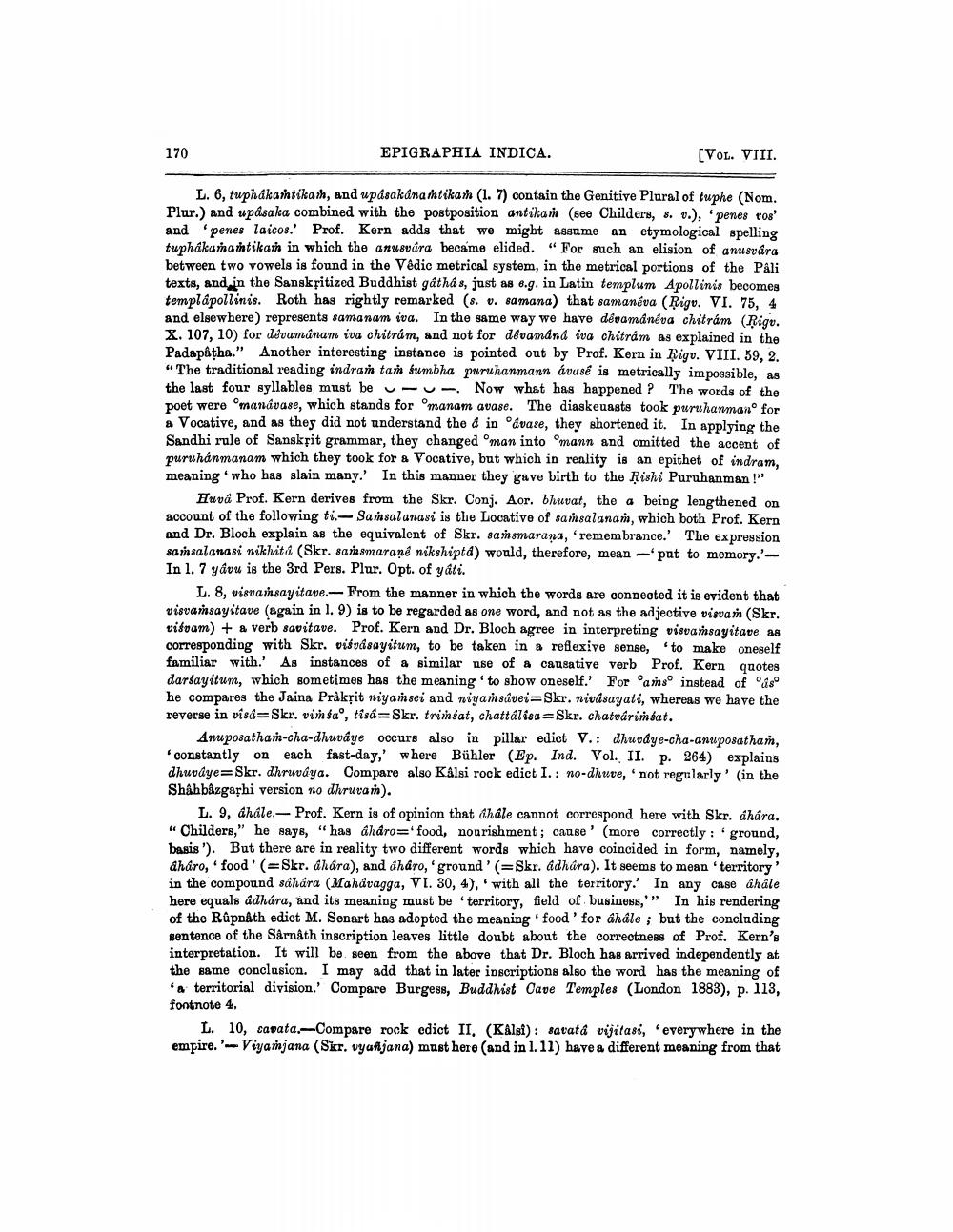________________
170
EPIGRAPHIA INDICA.
[VOL. VIII.
L. 6, tuphakantikam, and updsakána intikam (1. 7) contain the Genitive Plural of tuphe (Nom. Plur.) and updsaka combined with the postposition antikarh (see Childers, s. v.), 'penes tos' and penes laicos.' Prof. Kern adds that we might assame an etymological spelling tuphakamanitikan in which the anusvára became elided." For such an elision of anusvára between two vowels is found in the Vedic metrical system, in the metrical portions of the Pali texts, and in the Sanskritized Buddhist gáthás, just as 6.g. in Latin templum Apollinis becomes templápollinis. Roth has rightly remarked (s. v. samana) that samanova (Rigu. VI. 75, 4 and elsewhere) represents samanam iva. In the same way we have devamáneva chitram (Rigv. X. 107, 10) for dåvamånam iva chitrám, and not for devamånd iva chitrám as explained in the Padapatha." Another interesting instance is pointed out by Prof. Kern in Rigu. VIII. 59, 2. "The traditional reading indran tam fumbha puruhanmann ávusé is metrically impossible, as the last four syllables must be u-u Now what has happened? The words of the poet were manavase, which stands for manam avase. The diaskeuasts took puruhanmano for a Vocative, and as they did not understand the á in 'ávase, they shortened it. In applying the Sandhi rule of Sanskpit grammar, they changed man into mann and omitted the accent of puruhanmanam which they took for a Vocative, but which in reality is an epithet of indram, meaning who has slain many.' In this manner they gave birth to the Rishi Puruhanman!"
Huvá Prof. Kern derives from the Skr. Conj. Aor. bhuvat, the a being lengthened on account of the following ti.- Sansalanasi is the Locative of samsalanan, which both Prof. Kern and Dr. Bloch explain as the equivalent of Skr. samsmarana, remembrance. The expression samsalanasi nikhita (Skr. samsmarané nikshipta) would, therefore, mean –pat to memory.'In l. 7 yavu is the 3rd Pers. Plur. Opt. of yati.
L. 8, visvamsayitave.- From the manner in which the words are connected it is evident that visvansayitave (again in 1. 9) is to be regarded as one word, and not as the adjective visvan (Skr. vifuam) + a verb savitave. Prof. Kern and Dr. Bloch agree in interpreting visvamsayitave as corresponding with Skr. visvasayitum, to be taken in a reflexive sense, "to make oneself familiar with. As instances of a similar use of a causative verb Prof. Kern quotes darsayitum, which sometimes has the meaning to show oneself.' For aso instead of uso he compares the Jaina Prakrit niyansei and niyamsávei=Skr. nivasayati, whereas we have the reverse in visa=Skr. vimsa', tisa=Skr. trimsat, chattálisa=Skr. chatvárimbat.
Anuposatham-cha-dhuvaye occurs also in pillar edict V.: dhuraye-cha-anuposathan, constantly on each fast-day,' where Bühler (Ep. Ind. Vol. II. p. 264) explains dhuvdye=Skr. dhruvaya. Compare also Kálsi rock edict I. : no-dhuve, 'not regularly' (in the Shahbâzgarhi version no dhruram).
L. 9, dhale.- Prof. Kern is of opinion that dhâle cannot correspond here with Skr. áhára. * Childers," he says, "has ahdro='food, nourishment; cause' (more correctly : 'ground, basis '). But there are in reality two different words which have coincided in form, namely, dháro, 'food' (=Skr. dhara), and áháro, 'ground' (=Skr. adhara). It seems to mean 'territory' in the compound sahára (Mahavagga, VI. 30, 4), ' with all the territory. In any case dhale here equals adhára, and its meaning must be territory, field of business,'” In his rendering of the Rūpnáth edict M. Senart has adopted the meaning food' for dhale ; but the concluding sentence of the Sárnáth inscription leaves little doubt about the correctness of Prof. Kern's interpretation. It will be seen from the above that Dr. Bloch has arrived independently at the same conclusion. I may add that in later inscriptions also the word has the meaning of *& territorial division.' Compare Burgess, Buddhist Cave Temples (London 1883), p. 113, fontnote 4,
L. 10, cavata. Compare rock edict II, (KAlbi): savata vijitasi, everywhere in the empire.'-Viyanjana (Skr. vyafljana) must here (and in l. 11) have a different meaning from that




